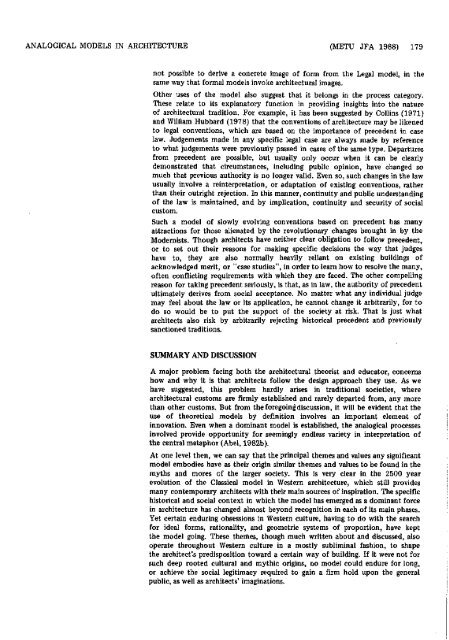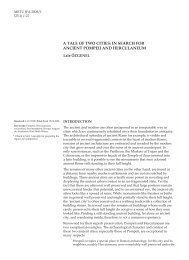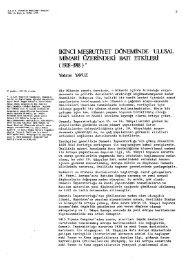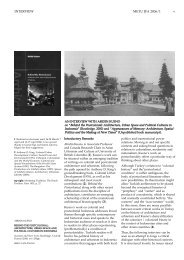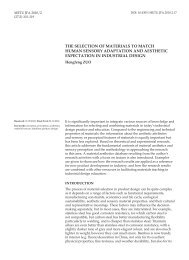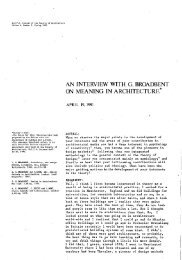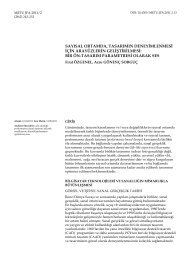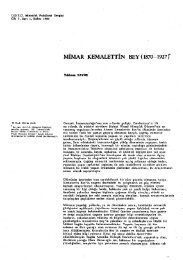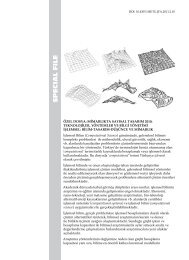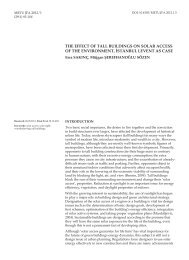ANALOGICAL MODELS IN ARCHITECTURE AND URBAN DESIGN l
ANALOGICAL MODELS IN ARCHITECTURE AND URBAN DESIGN l
ANALOGICAL MODELS IN ARCHITECTURE AND URBAN DESIGN l
Create successful ePaper yourself
Turn your PDF publications into a flip-book with our unique Google optimized e-Paper software.
<strong>ANALOGICAL</strong> <strong>MODELS</strong> <strong>IN</strong> <strong>ARCHITECTURE</strong> (METU JFA 1988) 179<br />
not possible to derive a concrete image of form from the Legal model, in the<br />
same way that formal models invoke architectural images.<br />
Other uses of the model also suggest that it belongs in the process category.<br />
These relate to its explanatory function in providing insights into the nature<br />
of architectural tradition. For example, it has been suggested by Collins (1971)<br />
and William Hubbard (1978) that the conventions of architecture may be likened<br />
to legal conventions, which are based on the importance of precedent in case<br />
law. Judgements made in any specific legal case are always made by reference<br />
to what judgements were previously passed in cases of the same type. Departures<br />
from precedent are possible, but usually only occur when it can be clearly<br />
demonstrated that circumstances, including public opinion, have changed so<br />
much that previous authority is no longer valid. Even so, such changes in the law<br />
usually involve a reinterpretation, or adaptation of existing conventions, rather<br />
than their outright rejection. In this manner, continuity and public understanding<br />
of the law is maintained, and by implication, continuity and security of social<br />
custom.<br />
Such a model of slowly evolving conventions based on precedent has many<br />
attractions for those alienated by the revolutionary changes brought in by the<br />
Modernists. Though architects have neither clear obligation to follow precedent,<br />
or to set out their reasons for making specific decisions the way that judges<br />
have to, they are also normally heavily reliant on existing buildings of<br />
acknowledged merit, or "case studies", in order to learn how to resolve the many,<br />
often conflicting requirements with which they are faced. The other compelling<br />
reason for taking precedent seriously, is that, as in law, the authority of precedent<br />
ultimately derives from social acceptance. No matter what any individual judge<br />
may feel about the law or its application, he cannot change it arbitrarily, for to<br />
do so would be to put the support of the society at risk. That is just what<br />
architects also risk by arbitrarily rejecting historical precedent and previously<br />
sanctioned traditions.<br />
SUMMARY <strong>AND</strong> DISCUSSION<br />
A major problem facing both the architectural theorist and educator, concerns<br />
how and why it is that architects follow the design approach they use. As we<br />
have suggested, this problem hardly arises in traditional societies, where<br />
architectural customs are firmly established and rarely departed from, any more<br />
than other customs. But from theforegoinğdiscussion, it will be evident that the<br />
use of theoretical models by definition involves an important element of<br />
innovation. Even when a dominant model is established, the analogical processes<br />
involved provide opportunity for seemingly endless variety in interpretation of<br />
the central metaphor (Abel, 1982b).<br />
At one level then, we can say that the principal themes and values any significant<br />
model embodies have as their origin similar themes and values to be found in the<br />
myths and mores of the larger society. This is very clear in the 2500 year<br />
evolution of the Classical model in Western architecture, which still provides<br />
many contemporary architects with their main sources of inspiration. The specific<br />
historical and social context in which the model has emerged as a dominant force<br />
in architecture has changed almost beyond recognition in each of its main phases.<br />
Yet certain enduring obsessions in Western culture, having to do with the search<br />
for ideal forms, rationality, and geometric systems of proportion, have kept<br />
the model going. These themes, though much written about and discussed, also<br />
operate throughout Western culture in a mostly subliminal fashion, to shape<br />
the architect's predisposition toward a certain way of building. If it were not for<br />
such deep rooted cultural and mythic origins, no model could endure for long,<br />
or achieve the social legitimacy required to gain a firm hold upon the general<br />
public, as well as architects' imaginations.


